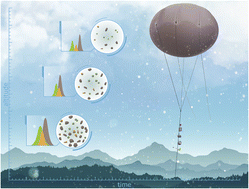An automated size and time-resolved aerosol collector platform integrated with environmental sensors to study the vertical profile of aerosols†
Abstract
Atmospheric particles affect human health, climate, and ecosystems but assessing their impacts is still challenging. Part of that is because of the limited understanding of the size dependence of particle properties and variation of these properties along with the vertical profile under different environmental conditions. Thus, we present a vertical gradient of size-resolved aerosol composition by deploying an automated size and time-resolved aerosol collector (STAC) platform integrated with sensors on the Atmospheric Radiation Measurement's (ARM) tethered balloon system (TBS) at the Southern Great Plains (SGP, Oklahoma) site. Our results highlight variations in atmospheric processing and aerosol sources along the vertical column by showing similar compositions with different size distributions of particles at various altitudes. The platform has been deployed in several other ARM campaigns in Oliktok Point (Alaska), Houston (Texas), and Crested Butte (Colorado). The STAC platform is loaded with an array of 4-stage cascade impactors to collect aerosol particles within different aerodynamic size ranges up to 20 sampling points per flight for various atmospheric research studies, such as the vertical profile of size-resolved aerosol chemical composition and multi-phase chemistry. Time-resolved sampling facilitates the study of the evolution of particles in the atmosphere. The battery-powered, lightweight automated size- and time-resolved sampling system is ideal for unmanned aerial systems (e.g., TBS) and aircraft sampling. The STAC platform is integrated with a temperature and relative humidity sensor and a pressure sensor to monitor ambient conditions, an optical particle counter to measure aerosol size distribution, and a micro-aethalometer to measure the black carbon mass concentration. Experimentally derived 50% cut-off sizes of each stage (stages A to D) for a standard impactor are about 2.3, 0.62, 0.42, and 0.12 μm. The impactor is adaptable to collect smaller particles with an additional replaceable stage E with a 50% cut-off size of 0.07 μm. The STAC platform facilitates simultaneous sampling of aerosols on three different types of substrates for multi-modal offline analysis to probe their physical (e.g., phase state and morphology), chemical (e.g., the elemental composition of individual particles and size-resolved chemical composition), optical (light absorption and scattering), hygroscopic and ice nucleation properties.

- This article is part of the themed collection: Applications of Unmanned Aerial Systems in Atmospheric Science


 Please wait while we load your content...
Please wait while we load your content...